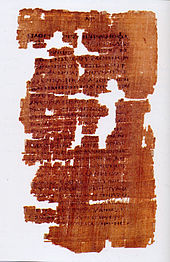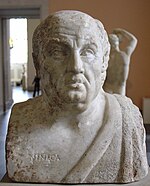Correspondence of Paul and Seneca
The Correspondence of (or between) Paul and Seneca, also known as the Letters of Paul and Seneca or Epistle to Seneca the Younger, is a collection of correspondence claiming to be between Paul the Apostle to Seneca the Younger. There are 8 epistles from Seneca, and 6 replies from Paul.[1] Jerome mentioned them in his De Viris Illustribus (chap. 12).[2] Until the Renaissance, the epistles were seen as genuine, but scholars began to critically examine them in the 15th century, and today they are universally held to be forged.[3] J. B. Lightfoot noted:
The poverty of thought and style, the errors in chronology and history, and the whole conception of the relative positions of the Stoic philosopher and the Christian Apostle, betray clearly the hand of a forger.[4]
Philip Schaff in his history said: "They are very poor in thought and style, full of errors of chronology and history, and undoubtedly a forgery."[5] Again, Lightfoot said:
This correspondence was probably forged in the fourth century, either to recommend Seneca to Christian readers or to recommend Christianity to students of Seneca.
As they are now universally allowed to be spurious, it will be unnecessary to state at length the grounds of their condemnation. It is sufficient to say that the letters are inane and unworthy throughout; that the style of either correspondent is unlike his genuine writings; that the relations between the two, as there represented, are highly improbable; and lastly, that the chronological notices (which however are absent in some important MSS) are wrong in almost every instance. Thus, independently of the unbroken silence of three centuries and a half about this correspondence, internal evidence alone is sufficient to condemn them hopelessly.[6]
References[]
- ^ Ehrman, Bart D. (2005). Lost Christianities: The Battles for Scripture and the Faiths We Never Knew (Illustrated, Reprint ed.). Oxford University Press. p. 206. ISBN 9780195182491.
- ^ Dodson, Joey; Briones, David (2017). Paul and Seneca in Dialogue. BRILL. p. 28. ISBN 9789004341364.
- ^ "Letters of Paul and Seneca". EarlyChristianWritings.com. Retrieved 20 July 2018.
- ^ Lightfoot, Joseph Barber (1892) "St Paul and Seneca". Dissertations on the Apostolic Age
- ^ Schaff, Philip. "St. Paul and the Conversion of the Gentiles". ' History of the Christian Church, Vol.1, Chap.V, Sect.I, Sub.2
- ^ J. B. Lightfoot (1890). "The Letters of Paul and Seneca".
External links[]
 English Wikisource has original text related to this article: Correspondence of Paul and Seneca
English Wikisource has original text related to this article: Correspondence of Paul and Seneca- The Correspondence of Paul and Seneca, translated by M. R. James, 1924 (Wesley Center Online)
- Apocryphal epistles
- Pseudepigraphy
- Cultural depictions of Paul the Apostle
- Cultural depictions of Seneca the Younger
- New Testament apocrypha stubs

